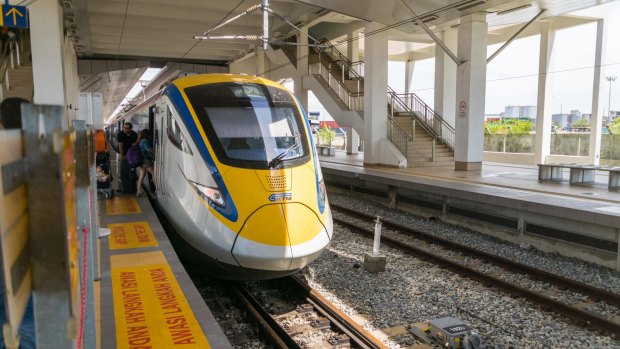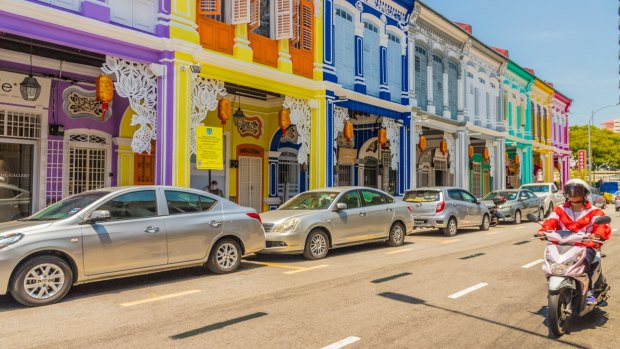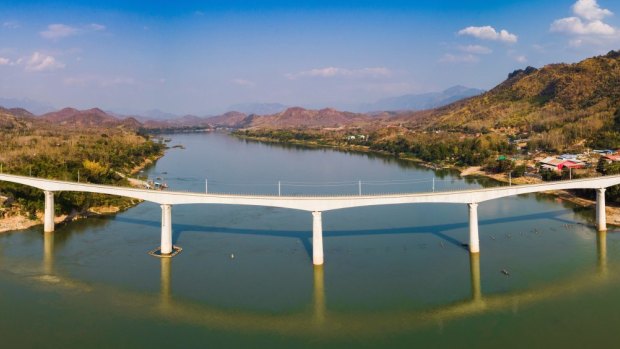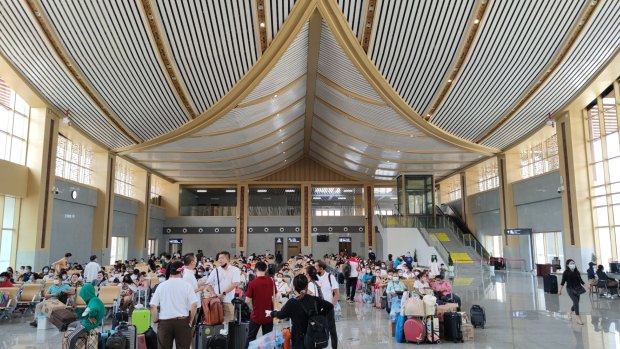This was published 1 year ago
Singapore to Luang Prabang, Laos, train journey: Travelling on a 'Belt and Road' China-built railway
By Kurt Johnson

The route from Singapore to Luang Prabang takes you through Malaysia.Credit: Alamy
Singapore to Luang Prabang by train became possible only in December 2021 as the world was peeking out from lockdown. Part of China's Belt and Road Initiative, the Laos to China railway, one of three planned branches, the others through Myanmar and Vietnam, will one day converge on Bangkok.
For passengers this closes a chain that more-or-less connects Singapore along four thousand kilometres of metre gauge track to the Chinese network. More-or-less because the purist will take exception to the short hops in sputtering rickshaw across borders.
The flight from Singapore to Luang Prabang would be like any other, outside only shades of black or blue. By train however it is not one journey but many. Traversing the length of Malaysia and Thailand, it passes decaying former British, French and Portuguese colonies, when Mosque minarets and Hindu temples momentarily become Christian spires then to Buddhist pagodas.

Colourful George Town on Penang Island, Malaysia. Credit: iStock
The rail network represents not just growing Chinese influence, but a history of contest. The Malaysian portion was built by the British to aid colonial extraction to ports, while Thailand, never colonised, decided their railways would mark an embrace of modernity (so too the royal decree for forks over chopsticks).
When the Japanese invaded they drove thousands of POWs and South-East Asian workers, called rōmusha, through inhuman conditions to build the Burma railway. It purpose: to supply troops so Japanese ships could avoid allied submarines prowling the Malacca Strait.
Over a week, I prioritise food and colonial architecture. Beginning in Singapore, an excellent launchpad, the culture-shock is manageable for my first post-COVID trip. I sense the famous sterility of the city-state, as if everyone works, eats well but nobody really lives. Only once I cross the Johor Straits into Malaysia have I begun a true journey, a sense I dimly recall from before COVID.

The Laos to China railway includes a new bridge over the Mekong.Credit: Getty Images
The first stop is Malacca, famous for its Portuguese colonial architecture and Nyonya cuisine, a melding of Javanese, Malaysian, Indian and Chinese styles that help produce the Laksa. I am there, by chance, during the Chinese Ghost Festival when processions of Malaysians of Chinese heritage tear through the narrow lantern lit streets to honour ancestors.
Next is Penang Island's George Town, with its packed British colonial buildings. After dusk, Kimberly street opens up as a night market selling barbecue by the skewer and bowls of koay teow th'ng, a clear and sweet noodle soup. My duck soup is prepared by two brothers. They bicker the entire time, ignoring customers except when exchanging money and passing the steaming bowl.
I find myself resorting to cliche but the journey actually is the destination. Liberated from my to-do lists and mobile reception I see the landscape change, from Malaysia's palm tree plantations, to the rice paddies of Thailand, passing through villages, catching glimpses down thronging market streets, then all is wiped clean, a fine metaphor for transience, from the Latin, to pass through.

Modern Luang Prabang Station.Credit: Getty Images
And then there are the other passengers. On the overnight train from Padang Besar to Bangkok, beside me is a Buddhist monk in saffron robes. By morning, as the train skirted the Myanmar border, outside last scraps of fog cling to the distant mountains, the other passengers come to offer alms, donating boiled rice and simple snacks, that the monk humbly accepts.
But it is a late middle aged man called Mardi with whom I strike up a conversation on a train through Malaysia that sticks with me. As the palm plantations passes, he tells me his life story. Once a promising PhD student, writing about Indian politics's influence over the region's Tamil population, Mardi had caught a severe case of dengue fever. Doctors told him he would never fully recover. After months of rehabilitation, he grew strong but his once-formidable memory never returned. Unable to focus, he was forced to surrender his studies.
In a moment of clarity, he realised his passion for learning had required neglecting his family. "I heard my daughter tell a neighbour that I was never home and didn't care about her," he says. He vowed to become a devoted father. At one connection we share a curry platter as we wait. Despite my protestations, he insists on paying.
Such experiences await the traveller willing to submit to this journey. It invites camaraderie beyond that normally afforded to the gawking, camera snapping tourist. You are always sharing something if only the journey itself.
My journey takes me to the capitals of Kuala Lumpur and Bangkok, which for all their bustle are yet to fully return to their pre-COVID frenzy then a full day train to Laos. Vientiane station stands aside from others in South-East Asia. It is self-consciously new, its airy, prefabricated style suggests lightning fast construction and the face of Chinese power. Gone are the hawkers and the smells and sounds spilling in from the streets. Here baggage is scanned, facemasks required (at the time) upon entry. In other terminuses, the trains rattle in, squeal, then stop with a sigh. Here the Chinese made CR200J glides in without a sound.
Before it, Laotians flew or spent an entire day in a mini-van winding their way 300 kilometres up and down towering limestone mountains. The carriage is clean and new. Outside, the route is an engineering marvel, with 75 tunnels, the latter half feels subterranean. The further north the rarer the moments we burst from a mountainside through a valley, a lone farmer in a rice paddy, hoe in hand, before burrowing back underground.
In Luang Prabang I alight for the last time and begin sweating immediately in the midday heat. The train pulls out and continues north where those who can, will cross into China's Yunnan Province and into lockdown. It may be a long time before war in Ukraine, sanctions and pandemics end, but when free movement resumes, a passenger may travel onward from here to Beijing then on the Transsiberian to Moscow, then through Europe to London or Istanbul without a single flight. For now this is far enough.
THE DETAILS
FLY
Singapore's Changi airport is served by many major airlines including Scoot and Jetstar for the budget conscious. The time poor can also join (or leave) at Bangkok or Kuala Lumpur.
PLAN
As with all international train travel, The Man in Seat 61 provides the most complete and up-to-date information in English. The section from Singapore to Malaysia contains a recommended timetable and details about getting to Penang from Butterworth and Malacca.
RIDE
Trains vary in quality between countries but all second class carriages are clean and have airconditioning (very important). Toilets are on board and if you forget to buy snacks, hawkers come through the carriages at major stations. Bring your own water. The whole journey from Singapore to Luang Prabang was very cheap costing around $140 in total. For the luxe option take the Eastern & Orient Express.
If you don't fancy lining up at the station, head to www.baolau.com. Baolau is smarter at connecting trains than competitor 12go.asia. For the final leg from Vientiane to Luang Prabang purchase tickets earlier than 4 days in advance. Any later will require buying in person waiting in long lines and buying from tellers with little English.
RETURN
Returning from Luang Prabang can involve multiple flights and become quite expensive. The cheaper and more comfortable option is to take the train, or a ferry down the Mekong, back to Vientiane then fly home.
The writer travelled at his own expense.
Sign up for the Traveller Deals newsletter
Get exclusive travel deals delivered straight to your inbox. Sign up now.